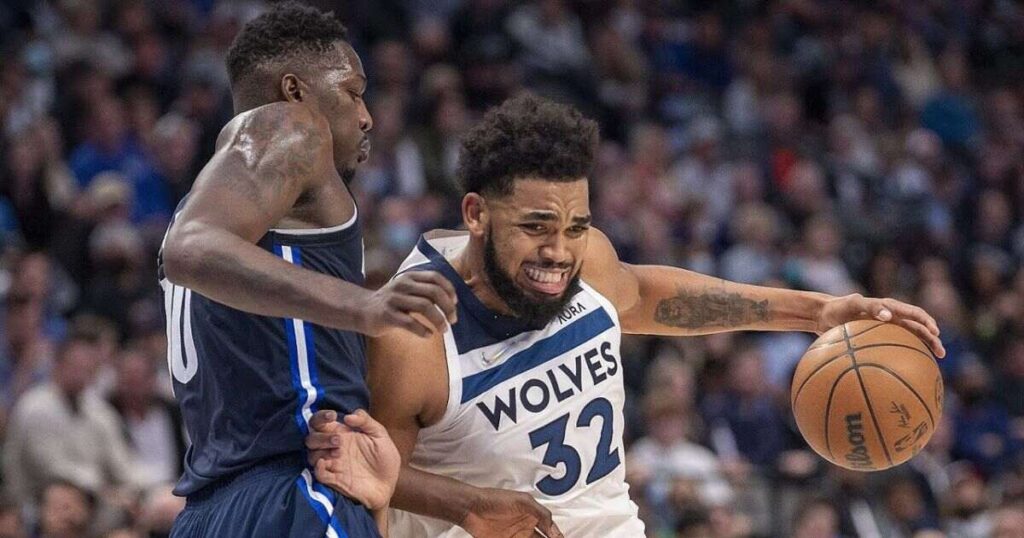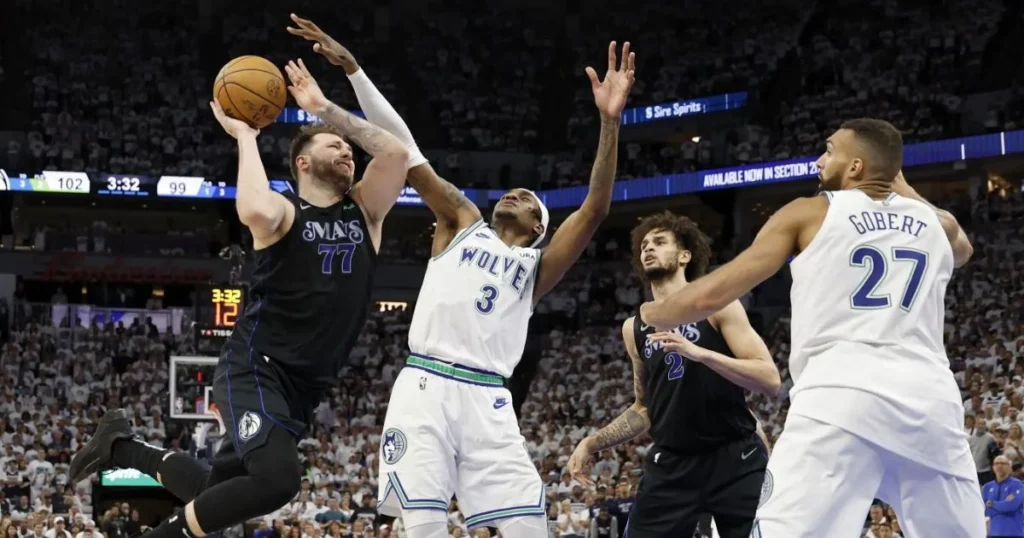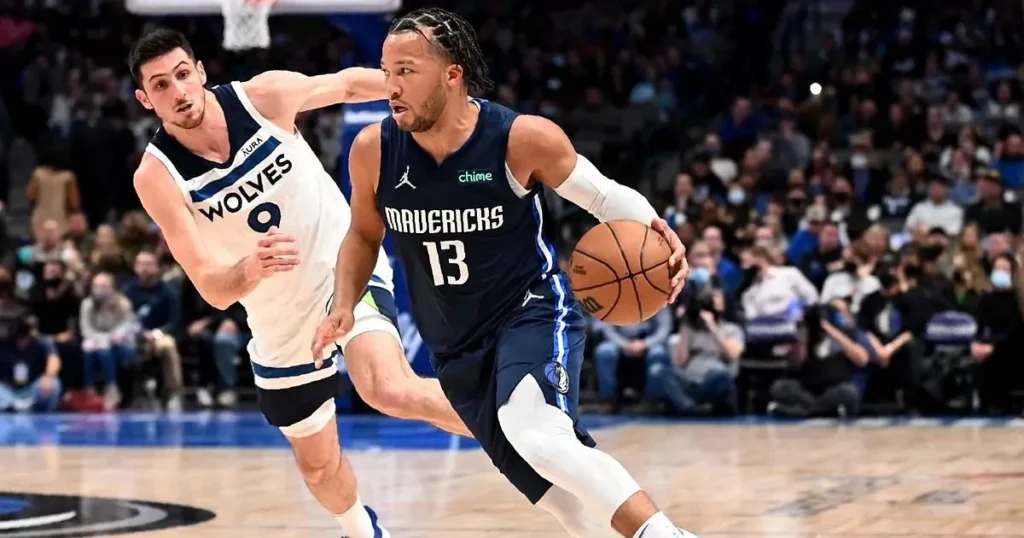The recent showdown between the Dallas Mavericks and Minnesota Timberwolves delivered an electrifying display of basketball prowess at the Target Center. The game, which held significant playoff implications for both Western Conference contenders, saw the Mavericks emerge victorious with a final score of 121-112.
In a season where every win counts toward postseason positioning, both teams brought their A-game to the hardwood. The Mavericks, currently sitting in the 6th spot in the Western Conference, needed this win to maintain their direct playoff qualification hopes, while the Timberwolves aimed to strengthen their grip on the top-four seed.
Star Player Showdown
The matchup featured an exceptional duel between two of the NBA’s most dynamic players. Luka Dončić, the Mavericks’ cornerstone, put up a masterclass performance with 30 points, 10 rebounds, and 8 assists, showcasing why he’s considered one of the league’s elite playmakers.
For the Timberwolves, Karl-Anthony Towns responded with an impressive stat line of 28 points, 12 rebounds, and 4 assists. His efficiency from beyond the arc (4-of-6 from three-point range) kept the Wolves within striking distance throughout the contest.
Critical Game Moments
The game’s turning point came during the fourth quarter when the Mavericks unleashed a 12-2 run, sparked by Dončić’s brilliant court vision and clutch shooting. His ability to create opportunities in high-pressure situations proved decisive in the final minutes.
Minnesota’s Anthony Edwards, despite facing tight defensive coverage, managed to contribute 24 points and 6 assists, but struggled with efficiency, shooting 9-of-23 from the field. This shooting difficulty reflected the Timberwolves’ overall offensive challenges during crucial stretches.
Team Statistics Breakdown
The Mavericks’ superior shooting efficiency told the story of the night. Their 48% field goal percentage, coupled with a remarkable 38% success rate from three-point territory, created consistent scoring opportunities throughout the game.
Conversely, the Timberwolves shot 44% from the field, with their offense occasionally stagnating against the Mavericks’ surprisingly resilient defense. Ball security proved problematic for Minnesota, as they committed 15 turnovers compared to Dallas’s 10.
Bench Impact

Dallas’s second unit made a significant impact, outscoring their counterparts 34-22. This bench production provided valuable rest for the starters while maintaining offensive pressure, highlighting the Mavericks’ improved roster depth this season.
The Timberwolves’ bench struggled to find their rhythm, managing just 22 points on a difficult shooting night. This disparity in bench scoring ultimately proved crucial in determining the game’s outcome.
Defensive Strategies
Both teams employed interesting defensive adjustments throughout the game. The Mavericks successfully contained Minnesota’s pick-and-roll offense, forcing them into tougher shot selections and disrupting their usual offensive flow.
The Timberwolves’ defensive scheme focused on limiting Dončić’s driving lanes, but his ability to hit step-back threes and find open teammates neutralized this strategy. Their defensive rotations often came a step too late against Dallas’s crisp ball movement.
Playoff Implications
This victory strengthens the Mavericks’ playoff positioning and demonstrates their ability to compete against top-tier Western Conference opponents. Their balanced offensive attack and improved defensive execution show promising signs for potential postseason success.
For the Timberwolves, while this loss stings, their competitive showing against a strong Dallas team provides valuable lessons for future matchups. Their need to maintain consistency in bench production and reduce turnovers becomes evident from this performance.
Player Development and Team Chemistry
The game highlighted significant developments in player dynamics for both squads. Dončić’s improved conditioning and leadership were evident in his fourth-quarter performance, where he logged heavy minutes without showing signs of fatigue.
Towns’ evolving role as both a post presence and perimeter threat demonstrates the Timberwolves’ offensive versatility. His chemistry with Edwards continues to grow, though their timing on pick-and-roll plays still shows room for improvement.
Technical Analysis
Breaking down the game’s advanced metrics reveals interesting patterns. The Mavericks’ true shooting percentage of 58.5% exceeded their season average, while their defensive rating showed marked improvement from recent performances.
The Timberwolves maintained their strong offensive rebounding numbers, securing 12 boards on that end, but struggled to convert these second chances into points. Their paint protection remained solid with 7 team blocks, though it wasn’t enough to overcome Dallas’s perimeter shooting.
Coaching Strategies

Both coaching staffs demonstrated tactical flexibility throughout the game. The Mavericks’ adjustments to Minnesota’s defensive schemes, particularly in screen actions, created favorable matchups for their shooters.
Minnesota’s staff experimented with various defensive coverages, but struggled to find consistent answers for Dallas’s spacing and movement. Their offensive sets showed creativity, though execution in crucial moments fell short of expectations.
Fan Engagement and Arena Atmosphere
The Target Center buzzed with playoff-like intensity throughout the contest. Over 18,000 fans created an electric atmosphere that peaked during crucial fourth-quarter possessions, showcasing the growing rivalry between these Western Conference competitors.
The crowd’s energy visibly impacted momentum swings, particularly during Minnesota’s third-quarter run that briefly gave them the lead. However, the Mavericks’ veteran composure helped them weather these emotional surges.
Injury Management and Minutes Distribution
Both teams demonstrated careful attention to player workload. The Mavericks’ rotation patterns kept their stars fresh for closing minutes, while Minnesota’s staff balanced competitive needs with long-term durability concerns.
This strategic approach to minutes distribution reflects both teams’ understanding of the marathon nature of the NBA season, particularly as they position themselves for playoff runs.
Social Media Reaction and Analysis
The game generated significant social media engagement, with highlights and key plays trending across platforms. Basketball analysts praised both teams’ execution while noting areas for improvement.
Fan discussions centered around playoff implications and individual performances, reflecting the growing national interest in both franchises’ development and potential.
Impact on Season Narrative
This game adds another chapter to the evolving story of both teams’ seasons. For Dallas, it reinforces their identity as a resilient road team capable of executing in high-pressure situations. Their balanced attack and improved depth suggest sustainability in their success.
The Timberwolves, despite the loss, showed flashes of their potential as a complete team. Their ability to stay competitive against top opponents, even on off-shooting nights, speaks to their growth as a unit.
Looking Ahead

Both teams showed why they’re considered serious contenders in the Western Conference. The Mavericks’ ability to close out tight games on the road bodes well for their playoff aspirations, while the Timberwolves display the talent and resilience needed for postseason success.
As the regular season progresses, these teams might cross paths again, potentially with even higher stakes. Their contrasting styles and star power make every matchup must-watch basketball for fans and analysts alike.
Read Also: Tampa Bay Rays vs New York Yankees Match Player Stats
FAQ’s
What are the predictions for Mavericks vs Timberwolves?
Based on recent form and head-to-head matchups, the Mavericks are slight favorites. Both teams match up well, but Dallas’s superior perimeter shooting gives them an edge in most predictions. Expect a close game with scoring in the 115-120 range for both teams.
Who are the best players in the Dallas Mavericks?
Luka Dončić is the Mavericks’ superstar and face of the franchise. Kyrie Irving serves as the second star. Tim Hardaway Jr. provides crucial scoring off the bench. Dereck Lively II has emerged as a promising young center. Josh Green offers defensive energy and improving offense.
Who are the Dallas Mavericks biggest rival?
The San Antonio Spurs are historically the Mavericks’ biggest rival. The Houston Rockets represent another strong in-state rivalry. Recently, the Phoenix Suns have emerged as a contemporary rival following intense playoff matchups.
How many times have the Dallas Mavericks won the NBA championship?
The Dallas Mavericks have won one NBA championship. They claimed their sole title in 2011, led by Dirk Nowitzki, when they defeated the Miami Heat in six games.
Where can I watch Dallas vs Minnesota?
Games are typically broadcast on Bally Sports Southwest for Dallas local coverage. NBA League Pass carries out-of-market games. National broadcasts appear on TNT, ESPN, or ABC. Local sports bars also regularly show Mavericks games.
Conclusion
The Mavs took down the Timberwolves 121-112 in what turned out to be quite a show. Luka Dončić was on fire with 30 points, while Towns answered back with 28 for the Wolves.
Dallas shot better all night, hitting 48% of their shots. Their bench stepped up big time, outscoring Minnesota’s reserves 34-22. The game stayed tight until the Mavs went on a fourth-quarter run that sealed the deal.
What really made the difference? Dallas’s sharp shooting and fewer turnovers. Plus, they handled the loud Target Center crowd like pros, showing they can win tough road games.
This win means a lot for playoff positioning, with both teams fighting for spots in the competitive Western Conference.


